
A cat jumps out of nowhere, startling our leggy heroine while snooping around some ruins, and a crusty, Dick Miller-esque librarian fleshes out the film's mythology when he reluctantly tells it to a couple of mythology-craving fashion victims during an impromptu visit. It's true, these are well-worn cliches that can be seen in almost every horror movie ever made. However, do any of the films that happen to sport these tired bits have blind mummies on horseback? I didn't think so. Slowly lurching, yet at the same time, galloping quickly, the zombies that populate Tombs of the Blind Dead (a.k.a. La Noche del Terror Ciego), Amando de Ossorio's eerie contribution to the undead pantheon, are peculiar brand of flesh-eater. For one thing, they carry broadswords and they perform their stalking mainly by ear–much like Gary Stevenson, the producer of Go West's self-titled debut album, stalks your eardrums with smooth basslines and fakakta keyboard explosions. Attracted to everything from the sound of you loudly chewing your grandma's paella to the thumping rhythm of your Iberian heartbeat, the dead in this film will find you (no matter what occurs). If you should manage to escape their clutches, don't get cocky, because they can ride horses as well. And while a visual impaired corpse on a horse doesn't sound that menacing, the sight of twelve of them barreling down on you in slow-motion will definitely cause you run in the opposite direction. I'd even go as far as to say that one might find themselves waist deep in a tangy pool of the yellowest fear-centric pee money can buy after experiencing the nightmare that is the bony horde.
 After a spooky opening credits sequence, one that does an excellent job of familiarizing us with the woebegone location we'll be spending the bulk of our cinematic time, we're about to witness one of the most awkward reunions ever to be staged between two former college roommates at a Portuguese resort in a mummy movie that's about equestrian zombies.
After a spooky opening credits sequence, one that does an excellent job of familiarizing us with the woebegone location we'll be spending the bulk of our cinematic time, we're about to witness one of the most awkward reunions ever to be staged between two former college roommates at a Portuguese resort in a mummy movie that's about equestrian zombies. Lounging on a deck chair with her favourite magazine, her black and white bikini accentuating the health of her attractive frame, Virginia (María Elena Arpón) spots a woman in a red and white bikini showering poolside–the cool water, slowly trickling down her firm body, is absorbed by the flimsy fabric of her na moda bathing suit. Removing her large sunglasses glasses, she calls out to the moist woman. It turns out it's Bette (Lone Fleming), Virginia's best friend from college. The two of them, while cordial at first, start taking subtle jabs at one another. You would think the introduction of Virginia's "friend" Roger (César Burner) would quell some of the verbal sniping, but that's where you'd be wrong.
Lounging on a deck chair with her favourite magazine, her black and white bikini accentuating the health of her attractive frame, Virginia (María Elena Arpón) spots a woman in a red and white bikini showering poolside–the cool water, slowly trickling down her firm body, is absorbed by the flimsy fabric of her na moda bathing suit. Removing her large sunglasses glasses, she calls out to the moist woman. It turns out it's Bette (Lone Fleming), Virginia's best friend from college. The two of them, while cordial at first, start taking subtle jabs at one another. You would think the introduction of Virginia's "friend" Roger (César Burner) would quell some of the verbal sniping, but that's where you'd be wrong. Even though it's viewed from the side, the perturbed expression on Bette's face when Virginia refers to her mannequins as "puppets" went way beyond my expectations of what a woman should look like when her vocation is dismissed by a former college roommate in a public forum. Ill at ease with the sheer amount of vitriol oozing in front of him, Roger suggests that Bette come along with them on a trip (and it is trip). At this point, it's Virginia's turn to look annoyed. But after some mild arm twisting, they all agree. Of course, Virginia secretly hopes that Bette doesn't show up at the train station. Clearly aware of her third wheel status, Bette gives them opening to give her shapely, sanely symmetrical backside the boot just before the train's about to leave. But Roger insists that she come.
Even though it's viewed from the side, the perturbed expression on Bette's face when Virginia refers to her mannequins as "puppets" went way beyond my expectations of what a woman should look like when her vocation is dismissed by a former college roommate in a public forum. Ill at ease with the sheer amount of vitriol oozing in front of him, Roger suggests that Bette come along with them on a trip (and it is trip). At this point, it's Virginia's turn to look annoyed. But after some mild arm twisting, they all agree. Of course, Virginia secretly hopes that Bette doesn't show up at the train station. Clearly aware of her third wheel status, Bette gives them opening to give her shapely, sanely symmetrical backside the boot just before the train's about to leave. But Roger insists that she come. As the train is chugging through the countryside, we learn why Virginia and Bette are so socially inept around one another. Apparently the two of them used to be more than just friends. In other words, the inside of their pretty mouth's have felt the billowy softness of each other's exceedingly wet undercarriages on more than one occasion. Now I realize that everything after "in other words" was completely unnecessary, as "more than just friends" would have been more than adequate. But what can I say? I love cunnilingus.
As the train is chugging through the countryside, we learn why Virginia and Bette are so socially inept around one another. Apparently the two of them used to be more than just friends. In other words, the inside of their pretty mouth's have felt the billowy softness of each other's exceedingly wet undercarriages on more than one occasion. Now I realize that everything after "in other words" was completely unnecessary, as "more than just friends" would have been more than adequate. But what can I say? I love cunnilingus. A brief soft focus flashback showing Virginia and Bette in their old college dorm room giggling over magazine articles, dancing in their nightclothes, and playfully loosening the binds of their uncommitted pigtails hammers home the potency of their lesbian relationship. Alluring and erotic as it may be, the awkwardness between them is too much for Virginia, so she decides to ditch Bette and Roger. Yeah, that's right, she impulsively hops off the train like some kind of high-strung hobo. Hoping to spend a night of Bette-less bliss in a town she spotted off in the distance, Virginia hits the dirt with a thud. Unfortunately, the town she is beginning to wander towards is called Berzano, the kind of place that makes plucky waitresses drop their trays at the mere mention of its name.
A brief soft focus flashback showing Virginia and Bette in their old college dorm room giggling over magazine articles, dancing in their nightclothes, and playfully loosening the binds of their uncommitted pigtails hammers home the potency of their lesbian relationship. Alluring and erotic as it may be, the awkwardness between them is too much for Virginia, so she decides to ditch Bette and Roger. Yeah, that's right, she impulsively hops off the train like some kind of high-strung hobo. Hoping to spend a night of Bette-less bliss in a town she spotted off in the distance, Virginia hits the dirt with a thud. Unfortunately, the town she is beginning to wander towards is called Berzano, the kind of place that makes plucky waitresses drop their trays at the mere mention of its name. The horror aspect of Tombs of the Blind Dead really begins to kick in once Virginia, utilizing the inordinate length of her exquisite gams (which have been genetically designed to withstand the elements), starts snooping around Berzano. Investigating every nook and cranny the town has to offer, all she comes across are creaky doors, empty buildings, faulty stairs, and weed covered walls.
The horror aspect of Tombs of the Blind Dead really begins to kick in once Virginia, utilizing the inordinate length of her exquisite gams (which have been genetically designed to withstand the elements), starts snooping around Berzano. Investigating every nook and cranny the town has to offer, all she comes across are creaky doors, empty buildings, faulty stairs, and weed covered walls. Settling in for evening in one of the town's many abandoned buildings, Virginia sheathes her sexy body in a blue sleeping bag. Hearing what sounds like horses galloping in the distance, Virginia gets up, puts on her denim short shorts (with a cheeky pocket on the front), and comes face to face the blind dead of Berzano, a slow moving, yet persistent horde of cloaking-wearing miscreants. As with most upright zombies, the walking blind dead are easy to avoid. However, it's a completely different story when the cavalry wing of the blind dead of Berzano set about looking for your denim-covered ass. Meanwhile, Roger and Bette are starting to worry about Virginia. Sure, she ditched them and all, but Bette feels responsible for her abrupt exist–you know, because of the whole lesbian flashback triggered in the train's caboose. And Roger, well, she's her "friend."
Settling in for evening in one of the town's many abandoned buildings, Virginia sheathes her sexy body in a blue sleeping bag. Hearing what sounds like horses galloping in the distance, Virginia gets up, puts on her denim short shorts (with a cheeky pocket on the front), and comes face to face the blind dead of Berzano, a slow moving, yet persistent horde of cloaking-wearing miscreants. As with most upright zombies, the walking blind dead are easy to avoid. However, it's a completely different story when the cavalry wing of the blind dead of Berzano set about looking for your denim-covered ass. Meanwhile, Roger and Bette are starting to worry about Virginia. Sure, she ditched them and all, but Bette feels responsible for her abrupt exist–you know, because of the whole lesbian flashback triggered in the train's caboose. And Roger, well, she's her "friend." Holding court at her mannequin workshop (the flashing red light was a terrific touch), and sporting a stylish green, yellow and blue shirt with geometric motif, Bette, determined to find out what happen to Virginia, teams up Roger. An elderly librarian (Francisco Sanz), while spinning a yarn about the blind dead's occultist roots (one that includes the torture and eating of a sacrificial maiden), puts them contact with his smuggler son, Pedro (José Thelman), a shifty man who operates near Berzano. Actually, the first person to find out what really happened to Virginia was a grinning morgue keeper (Simón Arriaga) who torments frogs in his spare time. But the less said about him, the better.
Holding court at her mannequin workshop (the flashing red light was a terrific touch), and sporting a stylish green, yellow and blue shirt with geometric motif, Bette, determined to find out what happen to Virginia, teams up Roger. An elderly librarian (Francisco Sanz), while spinning a yarn about the blind dead's occultist roots (one that includes the torture and eating of a sacrificial maiden), puts them contact with his smuggler son, Pedro (José Thelman), a shifty man who operates near Berzano. Actually, the first person to find out what really happened to Virginia was a grinning morgue keeper (Simón Arriaga) who torments frogs in his spare time. But the less said about him, the better. Your average mannequin factory and the local morgue may have a lot in common, but that doesn't mean they would make good neighbours. A recently re-animated victim of the blind dead, one who wanders over to the mannequin factory in search of sustenance, thinks they have stumbled upon an easy meal in the form of Nina (Verónica Llimera), the world's cutest mannequin factory employee. But they're about to find out that mannequin factory employees are extremely averse to having their flesh consumed by people who think strips of gauze can be worn as lingerie. Unabashedly brunette and wearing an unexpectedly chic sea green lab coat, Nina handles the undead threat with a clunky grace.
Your average mannequin factory and the local morgue may have a lot in common, but that doesn't mean they would make good neighbours. A recently re-animated victim of the blind dead, one who wanders over to the mannequin factory in search of sustenance, thinks they have stumbled upon an easy meal in the form of Nina (Verónica Llimera), the world's cutest mannequin factory employee. But they're about to find out that mannequin factory employees are extremely averse to having their flesh consumed by people who think strips of gauze can be worn as lingerie. Unabashedly brunette and wearing an unexpectedly chic sea green lab coat, Nina handles the undead threat with a clunky grace. Despite the fact that I thought Pedro's introduction scene was a tad on the long side, it is, however, the one responsible for inserting the luscious force of nature that was María Silva into the proceedings. Eating men for breakfast, brunch, lunch, high tea, dinner, and a bowl of cold cereal in nothing but your underwear at 1am, María Silva, with a giant slit in her gray skirt for maximum thigh-based titillation, is a total sex goddess in Tombs of the Blind Dead. Hell, she even had Roger wrapped around her sultry little finger, and he's an interior designer! Oh, and I loved how the majority of Maria's anecdotes seemed to revolve around drinking booze, doing drugs, or engaging in the act of sexual intercourse with grown men that are five or six years older than her.
Despite the fact that I thought Pedro's introduction scene was a tad on the long side, it is, however, the one responsible for inserting the luscious force of nature that was María Silva into the proceedings. Eating men for breakfast, brunch, lunch, high tea, dinner, and a bowl of cold cereal in nothing but your underwear at 1am, María Silva, with a giant slit in her gray skirt for maximum thigh-based titillation, is a total sex goddess in Tombs of the Blind Dead. Hell, she even had Roger wrapped around her sultry little finger, and he's an interior designer! Oh, and I loved how the majority of Maria's anecdotes seemed to revolve around drinking booze, doing drugs, or engaging in the act of sexual intercourse with grown men that are five or six years older than her. Countering Maria's cavernous slit with an orange skirt (one with a modest slit in the front) and white knee-high boots, Lone Fleming, and her wild, untamed Spanish eyes, dominates the blind dead showdown at Berzano with a stylish aplomb. Okay, maybe she didn't exactly "dominate," those who have seen the film will no doubt agree (her fleeing with a limp technique could definitely use some work). But she does look amazing, nonetheless.
Countering Maria's cavernous slit with an orange skirt (one with a modest slit in the front) and white knee-high boots, Lone Fleming, and her wild, untamed Spanish eyes, dominates the blind dead showdown at Berzano with a stylish aplomb. Okay, maybe she didn't exactly "dominate," those who have seen the film will no doubt agree (her fleeing with a limp technique could definitely use some work). But she does look amazing, nonetheless. Making a bold fashion statement in almost every scene she appears in, Lone Fleming's fabulous wardrobe–designed by Humberto Cornejo–is exactly what I would expect a woman who owns her own mannequin factory to look like. Her swanky vests, saucy berets, hats with wide-brims, shirts with strange floral patterns, and white footwear (including the aforementioned knee-high boots) all managed to dazzle the eye and uplift the spirit.
Making a bold fashion statement in almost every scene she appears in, Lone Fleming's fabulous wardrobe–designed by Humberto Cornejo–is exactly what I would expect a woman who owns her own mannequin factory to look like. Her swanky vests, saucy berets, hats with wide-brims, shirts with strange floral patterns, and white footwear (including the aforementioned knee-high boots) all managed to dazzle the eye and uplift the spirit.
The jarring and wholly original sight of cloak-wearing zombies on horseback; the coolness of Bette's mannequin factory; the skimpy outfits of the three main actresses; the morgue guy's sinister grin; and the creepy atmosphere of Berzano were all key components that went into making this unique zombie/mummy/devil-worshiping Knights Templar experience the mild success that it is.
video uploaded by 2ombieboy
...








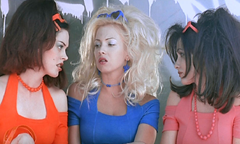


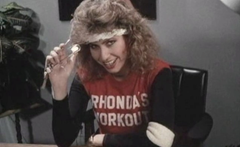




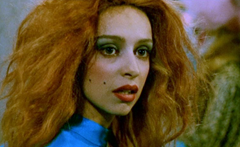

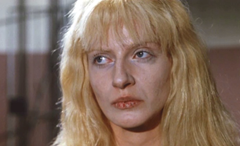








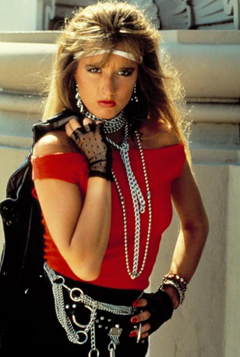




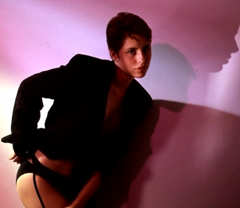



















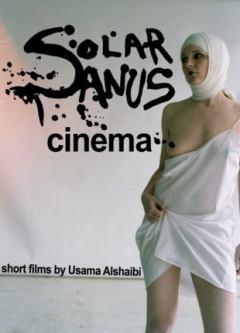
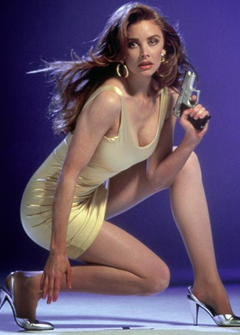
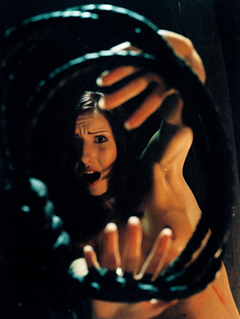
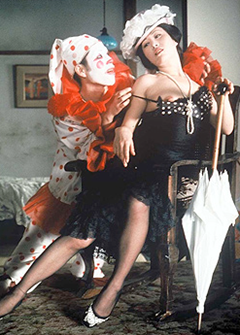
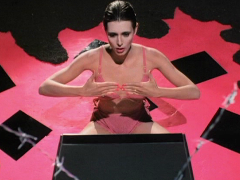
Nice, this is one of my favorite zombie movies.
ReplyDeleteMaria was my favorite femme in that one. To say her morals were loose would be an insult to the word loose.
ReplyDeleteEven though I usually flip-flop between Lone's Bette and Veronica's mannequin factory girl, Maria is an excellent choice; the slit in her skirt has the power destroy planets.
ReplyDelete